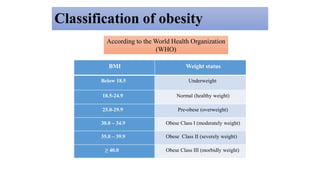Obesity and its consequences.pptx
- 1. Bangabandhu Sheikh Mujibur Rahman Science and Technology University, Gopalganj-8100 A Presentation on Obesity and it’s Consequences Presented by Md. Shimul Bhuia St.ID: 16PHR003 Department of Pharmacy
- 2. Obesity and its Consequences
- 3. Obesity • Obesity is one of the most serious global public health challenges of the 21st century, affecting every country in the Region. • Obesity is from the Latin obesitas, which means "stout, fat, or plump". • Obesity is a complex disease involving an excessive amount of body fat. • It's a medical problem that increases the risk of other diseases and health problems, such as heart disease, diabetes, high blood pressure and certain cancers. • Body mass index (BMI) is often used to diagnose obesity.
- 4. Classification of obesity BMI Weight status Below 18.5 Underweight 18.5-24.9 Normal (healthy weight) 25.0-29.9 Pre-obese (overweight) 30.0 – 34.9 Obese Class I (moderately weight) 35.0 – 39.9 Obese Class II (severely weight) ≥ 40.0 Obese Class III (morbidly weight) According to the World Health Organization (WHO)
- 5. Classification of obesitycont-- • Stores fat around abdominal region. • An apple-like body shape. • More at risk of having illnesses related to obesity like heart disease, metabolic syndrome and the ever- popular diabetes. • Other manifestation area: upper trunk like the upper chest (front or back) nape area of the neck, and even the shoulders. • Women→more masculine feature→Hirsutism. • Excess fats are being deposited somewhere at the hip and thigh areas. • Hips are rounded and buttocks generally look larger than normal. • People who are gynoid obese are called pear obese (pear fruit-like body shape). • Less at risk in developing chronic illnesses linked to obesity and overweight. • Much safer position than the android obese. According to fat distribution ANDROID OBESITY GYNOID OBESITY
- 7. OBESITY-The Complications Sex hormon imbalance Hormone dependen t tumors Increased free fatty acids Metabolic syndrome > Insulin resistance > Hypertension > Dyslipidemia Type 2 diabetes mellitus Cardiov ascular disease MORTALITY Physical stress > Sleep apnea > Ortheoarthritis > Low back pain > Shortness of breath DISABILITY Quality of life > Anxiety > Low self efficacy > Low self esteem > Disordered eating pattern > Potential low economic outcomes > Depression PSYCHOLOGY Complications related to obesity









